On KLRU’S Central Texas Gardener this week, I get to talk about one of my very favorite subjects, wildlife. Tom Spencer and I discuss ways to help wildlife during the blazing hot summer. Despite our brief bit of rain this week, the South continues to suffer from heat records and drought, and wildlife can be hit pretty hard by the severe conditions.
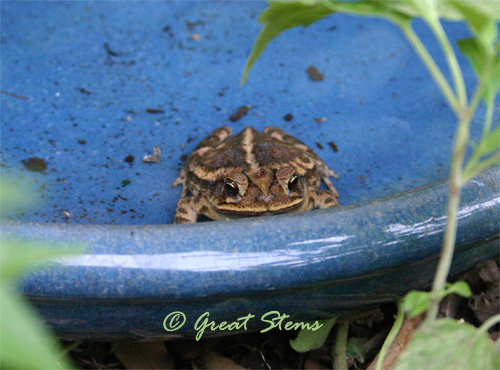
Low saucers of water are great for toads.
Water sources, of course, are priority one, and they don’t have to be big, fancy, or expensive. A saucer (or several) of clean water will do. We’re in the process of building another one of our budget-wise small ponds, so hopefully I’ll be able to report on it soon (and by typing this, I hope to ensure that it WILL be soon).
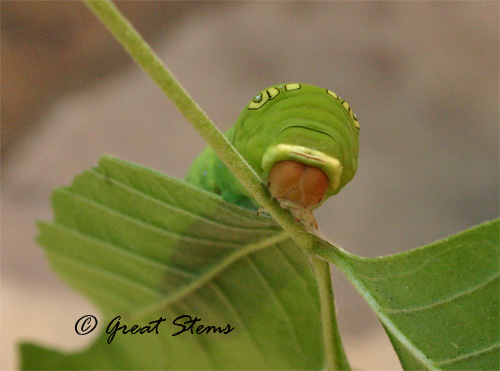
Caterpillars have specific host plant needs, like this Two-Tailed Swallowtail caterpillar munching on Wafer Ash.
Native plants are another priority, ones that serve as caterpillar hosts and/or offer seeds, fruits, pollen, nectar, nuts, or berries for the wildlife. I also supplement with birdfeeders, some with mixed seed and others with thistle, and I have several hummingbird feeders, as well. This gives birds all sorts of options to choose from.
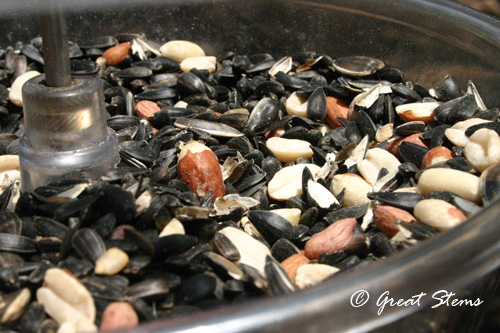
Songbirds love black oil sunflower and safflower seeds, peanuts, thistle, and other nutrient-rich foods. Just leave out milo and millet.
To invite songbirds, I like to use a mixture of black oil sunflower, striped sunflower, safflower, thistle, and peanuts. Sometimes I add cracked corn, but if pesty English House Sparrows start to show up, I leave out the cracked corn to discourage them. I generally create my own mix, and I don’t buy milo or millet because of the birds they attract.
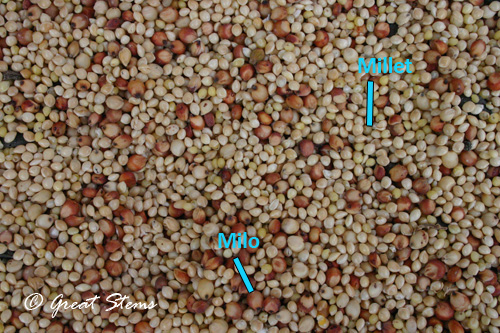
Milo and millet attract pest birds like English House Sparrows and Starlings.
Milo and millet are favorites of English House Sparrows and European Starlings, two non-native, invasive, and aggressive bird species. By aggressive, I mean that they will kill native birds such as Purple Martins or Bluebirds, drive birds out of their nesting areas, and destroy their eggs or young. Not only that, but they’ll eat all your birdseed before other birds can get to it! I’ve seen them get territorial at feeders, too. It’s very important to discourage these pest birds (and don’t let them use your nesting boxes or gourds).
White-winged Doves also love millet and milo. They are native birds, but they will quickly share the news that you are providing those seeds, and the next thing you know they and 30 other dove friends will be at your feeder all day long, taking turns with the English House Sparrows and Starlings and never letting any other birds have any.
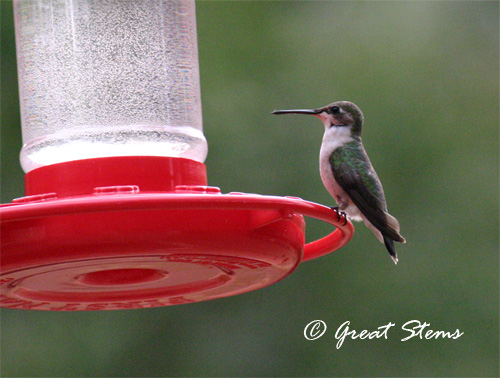
Just the feeder should be red, not the sugar-water mixture inside.
With hummingbird feeders, I recommend easy-to-open, easy-to-clean plastic hummingbird feeders that are all red in color. Glass is okay, too, but the feeder can break easily if it falls.
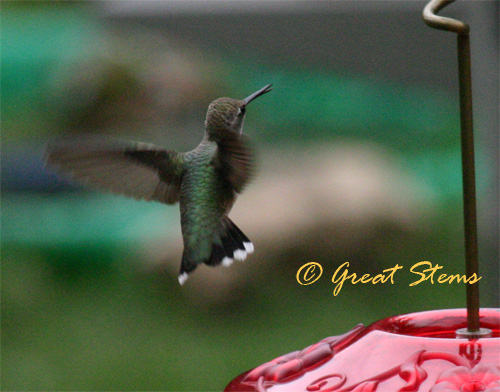
This saucer-style Hummzinger feeder has a moat for water to keep ants away.
You should be able to see every spot you are trying to clean — no nooks or crannies, and for your own ease, the fewer steps necessary, the better. Often, little bee guards (which are considered ineffective) or decorative flower attachments are a pain to clean, and that makes it more likely mold will grow.
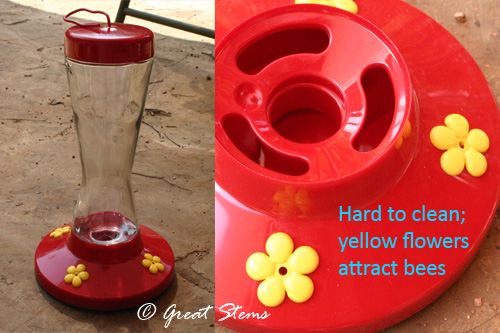
This feeder is seen at many stores, but it is difficult to keep clean, and those yellow flowers attract bees and wasps that might sting or chase off hummingbirds.
Why are all-red feeders the best choice? Those feeders with yellow and/or white flowers or other decorations sometimes bring in bees and wasps that are attracted to yellow and white colors. But bees and wasps can’t see the color red! Hummingbirds, on the other hand, love red. Bees and wasps also sometimes act aggressively toward hummingbirds and will even chase them off. My dad once witnessed a bee sting a hummingbird, and the hummingbird could not fly for several minutes. My dad watched over the bird until it was recovered enough to fly away.
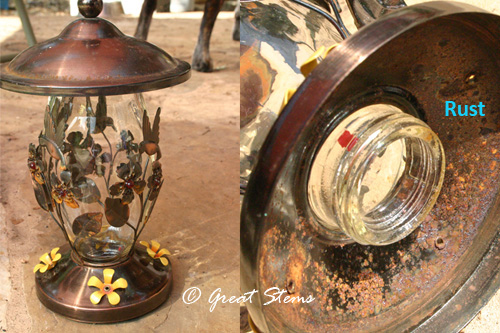
Iron from rusty feeders can build up in a hummingbird’s body and lead to its death.
I know that there are a number of pretty metal feeders out there, but stay away from them, please. Metal rusts, and the iron from the rust gets into the liquid and is consumed by the hummingbirds. However, they can’t get rid of the iron in their tiny little systems, and it can build up to the point of causing death. The hummingbird feeder in the above picture not only has rusty metal, but it also has yellow flowers and breakable glass. A triple threat!
The recommended mixture for hummingbird feeders is 4 parts water to 1 part ordinary white table sugar. Please don’t add red food coloring or buy red “nectar” mixes or use any other kind of sweetener.
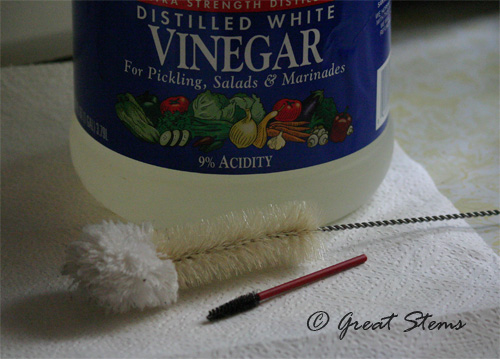 To keep feeders clean, I use water and vinegar, cleaning the feeder holes with a tiny brush and the inside of the feeder with a baby-bottle brush. I also make sure to replace the sugar mixture about every 3 days. Even with my five hummingbird feeders, the clean-and-refill task is quite fast.
To keep feeders clean, I use water and vinegar, cleaning the feeder holes with a tiny brush and the inside of the feeder with a baby-bottle brush. I also make sure to replace the sugar mixture about every 3 days. Even with my five hummingbird feeders, the clean-and-refill task is quite fast.
The same goes with birdbaths — keep them clean (a kitchen scrub brush with some vinegar works great) and replace the water every 3 days. This not only helps keep the birds safe, but it keeps mosquito larvae from completing the cycle to adulthood, at which point the little flying vampires would look to you for their next meal or meals.
My thanks to Linda, Tom, and the friendly CTG crew at KLRU for making me feel at home on the show. And thanks to everyone watching out for wildlife this hot summer!
Meredith, great tips, yet again and as always, fabulous photographs. It was just so much fun to have you on CTG, and I look forward to our caterpillar show!
Well, I didn’t know those yellow flowers attracted wasps – and that wasps couldn’t see red! Good info!
Linda, thank you again, and I’m looking forward to the caterpillar show, too!
Holley, it’s pretty cool how much a factor color is in the way nature works. Bob of Draco Gardens told me yesterday that tree frogs can change colors like chameleons — I didn’t know that!
I watched the show and you did a fabulous job. SO natural and you are doing a great job for our wildlife.
The birds hummingbirds, butterflies and frogs in my neighborhood thank you for the wonderful advice!
Jenny, thank you so very much. You said words I needed to hear! I normally much prefer being behind the camera instead of in front of it, but I was glad to be able to share some wildlife tips, because it sure has been a rough summer, with a long way to go.
I hope they all come give you a cheer in your garden, Judy!
How wonderful.. your garden show comments are important to all of us…I try to keep saucers filled for birds and toads ..of course the pond is essential for wildlife and my hummers refuse my feeders…they love to partake of all the flowers I planted for them…
Caught you on ctg and yelled,”Hey, I “know” her!”
Thanks for the good work. I was in the first class of Stewards back in 2000 or so. Funny, back then when Tom Spencer wrote to say he’d add a link to my website he said he was interested in featuring wildlife habitats on the show. Ten years later…there you are.
Follow you here and on FB, keep up your great work.
Meredith,
I learned a lot of new from your post. I didn’t know the bees and wasps couldn’t see the color red. neither I would expect a bee or wasp to attack a hummingbird.
It’s very important for us gardeners to provide food and water to the wildlife that visits our gardens, especially in extreme temperatures like we have them here in our hot Texas summers.
My bird feeders are all filled year around and I have several birdbaths that I fill with fresh water every single day. For the toads and froggies or the cute lizards I have placed several shallow bowls with water throughout my rock beds.
Donna, I know your wildlife is so grateful for all that you do! It’s great that the hummers prefer the flowers to the feeders — that’s what you want! In my garden, with the drought and heat being so terrible, they are going to both, for sure.
Jane, I’m just tickled pink that you stopped by to visit after watching CTG — I didn’t realize that you are a steward, too! Somehow I missed that when visiting your website, which is great by the way. I love all your tips!
Fantastic, Paulo Jo — you sure do a lot for wildlife. Sounds like you have a lot visiting your garden!
I saw you on CTG!!! Very informative- as is this and your other post. I had read it the other day but not commented. I was moving some pots today and a HUGE frog jumped out- made me think of you, I went out and got a little saucer and put water in it and put it out where he was. Hopefully he will find it (and others). I put a few out here and here. Great photo of the two tailed swallowtail by the way.
I love amphibian surprises! My best one is a toad I found in my shoe (I found it when I tried to put my shoe on outside).
It’s monsoon season here in Lahore-Pakistan.There are literally millions of tadpoles all around.Some of them have been flattened to the roads by the moving traffic.
When and if it ever rains here again, I expect our frogs will move about again — that’s when we find new bullfrogs in our pond. The tadpoles continue to be plentiful — I hope they’ll eat some mosquito larva. It’s tough that so many tadpoles are getting flattened by cars, but that’s one reason why frogs and toads lay so many eggs!
Pingback: Autumn Planting for Texas Wildlife Garden